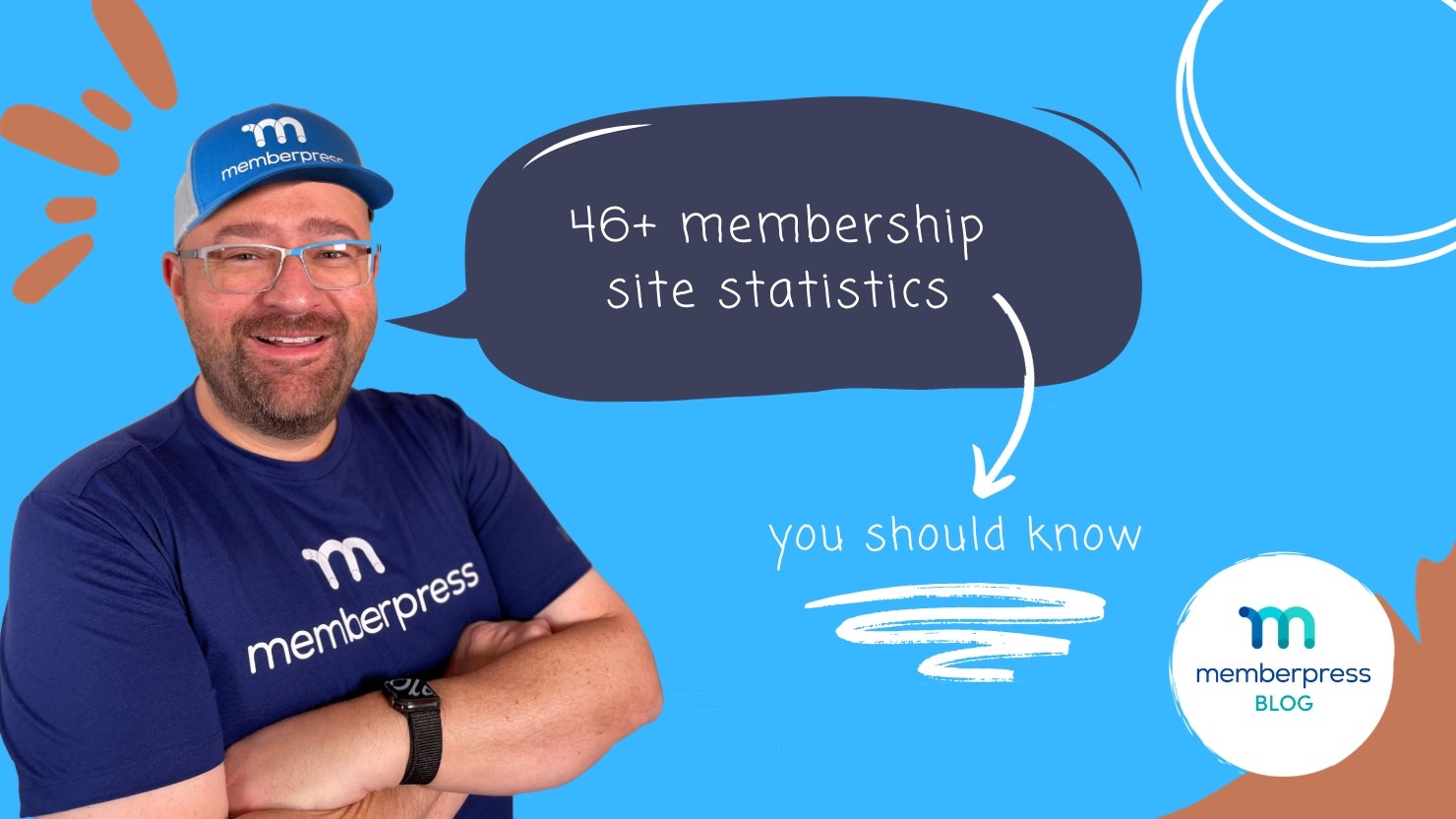Looking for awesome membership site statistics? You’re in luck! We’ve combed the internet to find the latest insights on membership businesses and the subscription economy.
The creator economy is going full force, making it easier than ever for entrepreneurs to turn a profit off their ideas. And starting a membership site is now a piece of pie with WordPress plugins like MemberPress.
But we thought you might be even more confident if you had a handy list of membership statistics to show you what’s happening in the membership economy today.
There are all kinds of membership websites across the internet. In this post, I’ve compiled statistics based on three common and popular types:
- Learning Management Systems (LMSs)
- Association Memberships
- Subscription Sites
If you’re reading this, it’s likely you’re a small business or an individual looking for ways to make recurring income – not a large corporate entity.
That’s why we’re looking at statistics around learning, associations, and subscription sites anyone can create.
The insights here can help you focus on the right marketing strategies for your business and help you understand what to expect in your industry’s future.
Ready to roll? Let’s go.
LMS Statistics

Online courses are a great way to add value and more offerings to your business.
That’s why more and more businesses are using learning management systems (LMS) to build online educational sites or add learning components to their membership sites.
MemberPress Courses is an LMS built right into MemberPress that allows you to do just that – fast and easy.
Let’s start by looking at the market for LMS platforms.
- In 2022 the global LMS market was valued at $16.19 billion, up from $14.43 billion in 2021. It is expected to grow to $47.47 billion by 2030, with a CAGR of 14.6%. (Fortune Business Insights)
- North America accounts for the largest market size using LMS platforms.
- Europe is projected to be the fastest-growing market.
- The highest source of revenue is projected to come from North America, followed by Europe.
These markets use LMS systems the most due to the high adoption rate of technology and the availability of internet infrastructure. (Straits Research) - There are 1000+ LMS vendors today. (Finance Online)
- The industries using LMS platforms can be broken down as follows:
- education (21%)
- technology (12%)
- manufacturing (9%)
- healthcare (7%)
- consulting (7%)
- software development (4%)
- non-profits (3%)
- real estate
- governmental bodies (2%)
(Webanywhere; Industry Insights)
- Of Fortune 500 companies, 41.7% use educational technology to train employees during formal training periods. (eLearning Industry)
- Today, over half (55%) of all LMS installations are deployed on the cloud while 45% are on-premise. (iSpring Solutions)
- Of LMS users, 89% access online courses using a desktop, while 76% of users access courses on a laptop, 25% through a tablet, and 19% via smartphone.
- Half of LMS buyers spend less than $5,000 on system implementation, whereas 1% of LMS implementations cost above $50,000.
- More than 50% of LMS buyers implement their platforms within six months, 24% of buyers need up to a year, and the remaining take more than a year to get their LMS platforms running.
- The top reason for dissatisfaction with an LMS platform is poor user experience (88%) followed by poor admin interface (74%).
- According to Finances Online, 93% of businesses surveyed plan to adopt LMS by adding live online learning to their programs. (Finances Online)
Association Memberships

Association memberships are typically smaller organizations that serve the interests of a profession or trade.
Associations are also related to charity and philanthropic works.
These bodies often recruit and support individual member organizations (IMO), trade groups, or a combination of the two.
Associations are built to develop and share knowledge and best practices and to help their members’ networks. They also support members and advocate for their interests.
Association membership organizations don’t cater to general consumers. The needs of members are unique, and each association may have its own specific culture based on the industry it’s in.
Let’s look at some helpful insights that will improve marketing an association and boosting recruitment.
- Why do people join associations? According to Marketing General, 64% say it’s to network with their peers. A full 39% join for special accreditation and continued education, and 33% of people want to learn about their industry’s best practices.
- Associations that recruit both individuals and trade bodies had the highest median growth (14%). Associations recruiting only individuals saw 12% growth, and those that took in trade bodies had a growth of 10%.
- The largest generational group in associations is the Baby Boomer generation (36%). Generation X forms the next highest group at 29%. Millennials typically constitute 20% and Generation Z, 6%.
- The overall recruitment channels that garner the most new members are word of mouth (69%), email (62%), and meetings (34%).
- Within digital recruitment channels, Facebook paid advertising is the most effective, generating 68% of new recruits, while 51% comes from SEO efforts, and 46% from remarketing.
- What are the most used social media platforms for associations? Facebook comes in first at 93%, Twitter is second at 82%, and LinkedIn comes in third at 72%.
- What’s the most effective social media platform for recruitment? Associations say it’s Facebook, while Twitter and other platforms are said to have a lower impact.
- A full 38% of associations that experience an increase in member renewal rates offer automatic annual renewal via credit card.
- Of associations, 25% say that creating targeted communication boosted member engagement.
- Another 16% attribute higher member engagement to using deliberate engagement strategies and an increased focus on members.
- Of associations in one study, 13% said they started, canceled, or modified events to find that member engagement grew, suggesting that quality matters over quantity. (GrowthZone)
- Higher member renewal rates are related to how well members recognize an association’s value proposition.
- Of organizations, 23% claim that higher renewal rates came from clearly identified value propositions, as opposed to associations where the value was unclear.
- Of associations, 42% state that having members understand their value proposition leads to increased net membership. In comparison, associations where the value proposition was vague had lower net membership rates.
- Paid advertising, including boosted social media posts, Google Ads, and others, were used by 71% of associations.
- A full 76% of associations don’t offer benefits or affinity programs to create returning members.
- Of surveyed associations, 44% reported an overall increase in memberships over 2022 – 2023. (GrowthZone)
- 27% of survey associations reported that member engagement got “better” over 2022 – 2023. (GrowthZone)
Subscription Memberships

Subscription-based businesses are growing in number. It’s the primary way that businesses and individuals can make a recurring income online.
Let’s jump right in and look at some important subscription model statistics. They’ll provide the most relevant insights you need to understand why the subscription economy is going to become the norm in the future.
- Last year (2022) the digital subscription market was valued at $650 billion.
- By 2025, the digital subscription economy is projected to grow to $1.5 trillion. (Lineup)
- 205 million Americans now use at least one subscription service, up from 182 million in Q1 of 2020.
- 75% of direct-to-consumer (DTC) brands are expected to have subscription based offerings by the end of this year. (RetailDive)
- 39% of all millennials and bridge millennials subscribe to at least one retail product. (Sticky.io)
- The average small business spends more than $15,500 every month on SaaS products. (Blissfully)
- Small businesses use an average of 20+ paid SaaS subscriptions.
- Of 504 senior business leaders representing retail, finance, and other industries, 70% believe that subscription models hold the key to growth. (Global Banking and Finance)
- Of surveyed senior finance executives, 53% say that 40% of their organization’s revenues are sold via the subscription model. (CFO)
- Of C-level executives and board members, 23% are incorporating subscription and membership models as part of their future strategies, while 17% of responding businesses will launch new or additional recurring revenue businesses in the near future.
- Of businesses, 82% are adopting subscription models because it enables them to become leading disruptors. (Citibank)
- A full 76% of businesses claim that a subscription-based model helps create customer retention and long-term relationships with customers.
- A full 34.9% of U.S. households will no longer have a traditional television subscription by 2027. (Insider Intelligence)
- A whopping 83% of U.S. households now have at least one video streaming subscription. (Leichtman Research Group)
- Music subscription services are booming, too, with 60% of households holding a subscription to at least one. (Cloudwards)
- Average annual growth of subscription billing vendors is between 30% and 50%. (The Paypers)
- In regard to churn rate, one report showed that a rate of 10% or less is good and under 5% is ideal. (Eligeo)
Conclusion
So there you have it! We hope you’ve gained useful insights into the state of the membership business model by looking at three different types of memberships.
As you can see, the subscription economy is strong and growing fast. Whether you plan on starting an online course, or you want to add a recurring revenue stream to your retail business, now’s a great time to ride the wave.
Focus on creating a quality product that will make your members’ lives more convenient and you’ll boost your bottom line year on year.
Choose robust tools and services from the start to help you set up and run your membership site with ease.
MemberPress is the world’s #1 monetization, LMS, and membership plugin for WordPress.
But don’t take our word for it, read our customer testimonials for yourself, and discover just how easy it is to get up and running in one day.

Get MemberPress Today!
Start getting paid for the content you create.
If you’re interested in more business statistics, here’s a helpful list of digital marketing statistics that’s sure to get you thinking.
If you know of any interesting statistics not mentioned here, we’d love to hear. Tell us about it in the comments!
















This was really interesting and very encouraging, being in the fitness membership space! 🙌
I found Blair’s article on Useful Membership Site statistics to be interesting and helpful when broadening my horizons, especially in the LMS department.
Thanks for the information